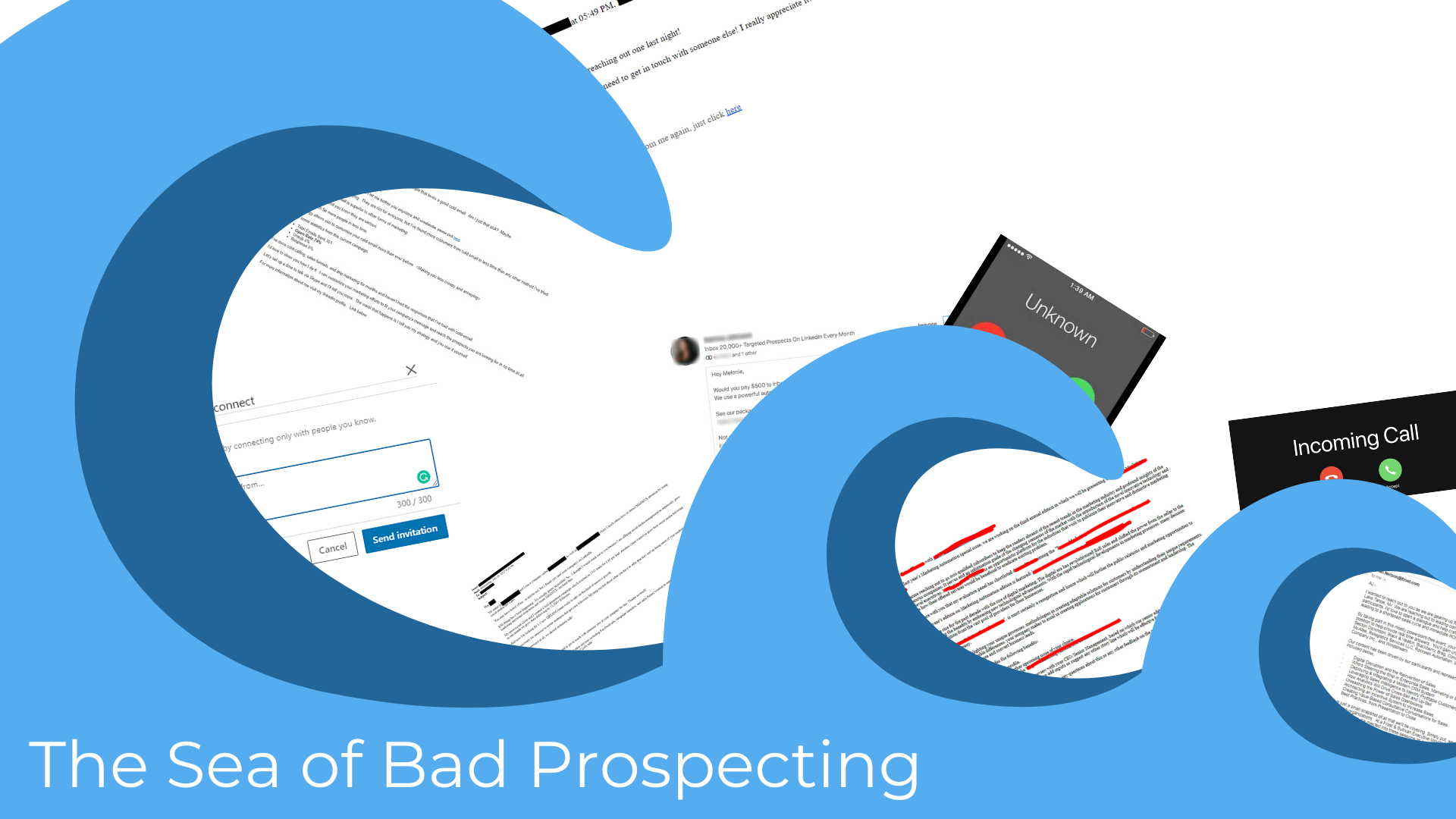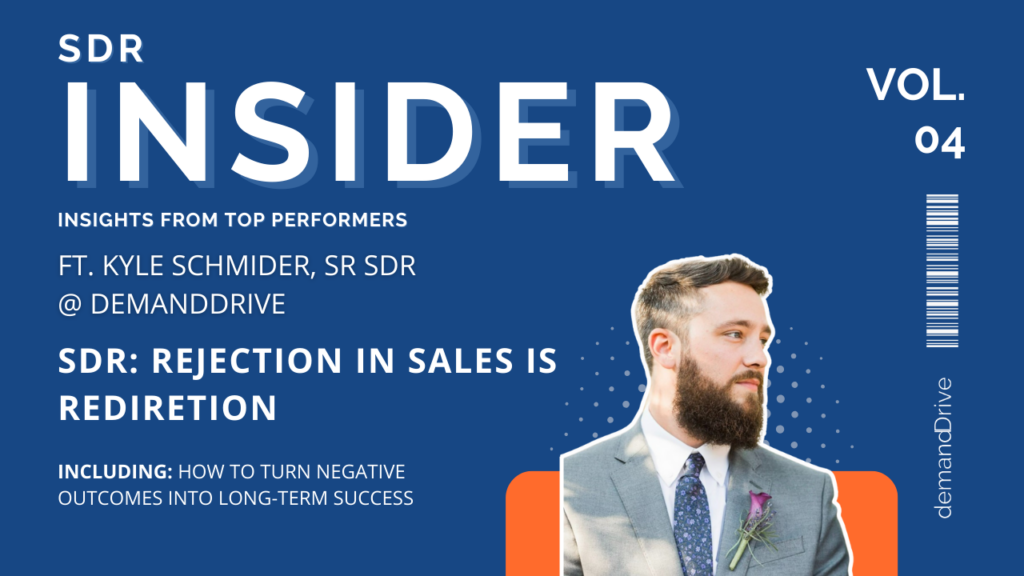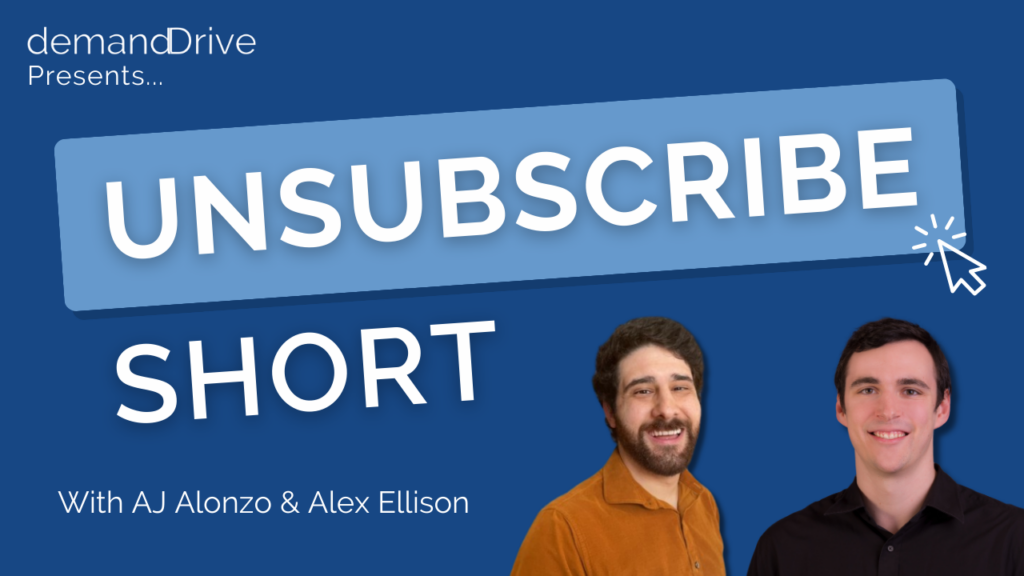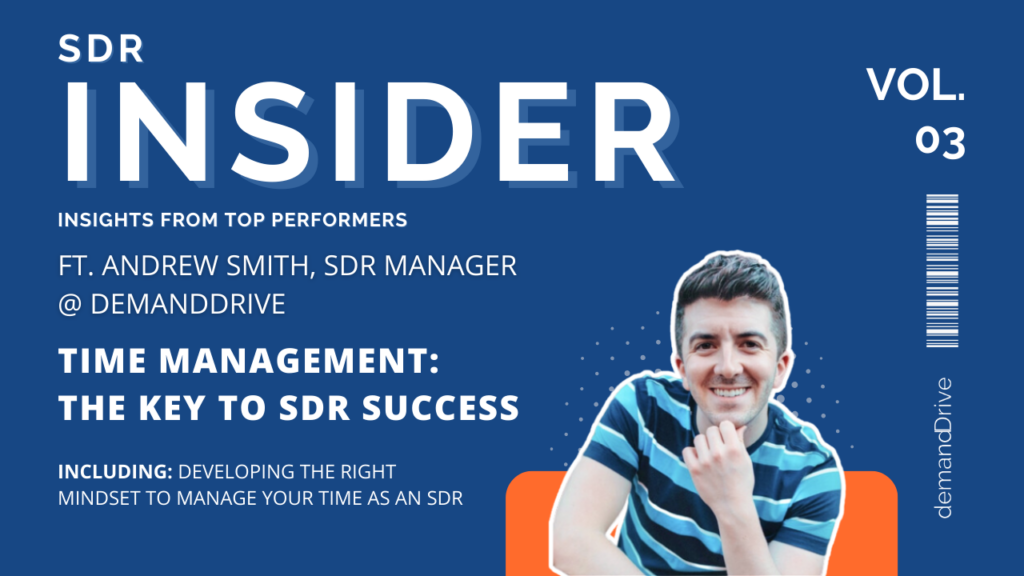Grabbing Attention & Building Relevance
5 Questions with Ethan Beute
⚠️ Grabbing Attention & Building Relevance
It’s harder than ever to grab and keep your prospects’ attention. How are you setting yourself up for success as an SDR?
It takes Trust, Warmth, and Competence. Ethan talks about how you can build that up as an SDR.
Grabbing and holding the attention of your prospects is harder now than it ever has been.
Email send rates are at an all-time high, and engagement is at an all-time low.
Social discourse around pitch slaps and untargeted messaging is reaching boiling points.
The sea of prospecting emails, phone calls, and LinkedIn messages continues to swell – and as an SDR, you can either sink or swim.
Choosing sink means you continue sending messages off into the void – hoping someone will respond.
Choosing swim means you craft relevant, novel messages with the notion that your prospects would be crazy to not respond.
Consider this episode a life vest.

And consider our guest, Ethan Beute, a certified lifeguard.
Ethan’s work at BombBomb is all about finding ways to craft relevant, novel messaging to really grab and keep prospects’ attention.
He talks through why this is so important, how you can start today, and even provides a handy flowchart to keep you on track.
Our Guest
What He Does: Ethan is the Chief Evangelist at BombBomb
How to Connect: Ethan’s LinkedIn
Ethan’s work at BombBomb is all about finding ways to craft relevant, novel messaging to really grab and keep prospects’ attention.
He talks through why this is so important, how you can start today, and even provides a handy flowchart to keep you on track.
Key Takeaways
-
Grabbing attention is critically important, and it’s more difficult than it ever has been. How can you cut through the noise? Any good examples of ways you’ve seen SDRs and AEs grab someone’s attention?
-
Caveat – properly grabbing their attention. Easy to get someone to look at your email, but not always for the right or relevant reasons.
-
-
Once you have someone’s attention, the chart flows to familiarity. Basically, how recognizable is the SDR or their company. How can someone build that familiarity with their prospects?
-
How much of it is on the rep vs. the company level?
-
-
Let’s move down the unfamiliar track. If you get an attention-grabbing message from someone you don’t know, there’s a level of novelty that comes into play. If it’s boring, it goes in the trash. But if it’s unique and you can see value, you read on. What are some best practices around creating novelty?
-
Is this just “relevance” or is that something else entirely?
-
-
The ultimate goal in your flowchart is trust. And we hear that a lot – if you want to be a successful SDR or AE, you need to earn your prospect’s trust. Outside of what we just touched on, what goes into building that trust?
-
And on the flip side, what are some things to avoid? It’s easier to lose trust than gain it.
-
-
How do you scale all of this? Can you scale it? And if you can’t, how can you make sure to incorporate this into your outreach?
Highlights, Notes, and Resources
Biggest Takeaways
🗺️ Here’s the chart in question (click it for a full-sized image). Study it and think about where your outbound messaging typically lands. Are you bringing novel ideas to the table and working to build trust with your prospects? Or are you trying to grab their attention with generic, irrelevant messaging? If you want results, you need to be very intentional with what you say and to who you say it.
⏳ Taking a long-term approach to sales development is the answer – especially if you want to build familiarity. Having your touchpoints talk with one another and complement each other builds up the familiarity and trust you need to get a response. The SDRs winning today are relaying a consistent message across multiple channels – not many disjointed messages across a single channel.
Stack the deck in your favor so that when someone picks up your phone call their first reaction isn’t “who is this” but “oh, it’s the SDR who’s been sending me great content.”
💡Every message you send trains people to open or delete your next message. Humans are really, really good at pattern recognition. And if you start to send untargeted, sloppy messaging to your prospects they will start to subconsciously ignore or delete you. And that makes playing the numbers game very dangerous.
🔍 Clear always beats clever.
🤖 “Until it’s machines making decisions with other machines on what to acquire, we’re still selling to human beings. And there’s a richness there that our systems and processes and the way that we’re deploying these tools and techniques need to honor.”
Conversation Highlights
Note: Timestamps correspond to the YouTube video
(5:45) Attention is the currency of the economy. But attention is just the first step.
Anyone can grab attention. What you do with it next is what’s important, and it’s where Ethan’s chart really shines. As you branch off the “attention” box you can still end up in the “ignore, delete, block” section.
You have to think past “grabbing” attention and really focus on rewarding it once you have it.
(6:58) You’re probably going to fall down into that “unfamiliar” path. That’s just the nature of the beast for most SDRs. And that means bringing something “novel” to prospects is crucial to your success.
That means narrowing your focus, list, and messaging – not tricks and gimmicks that bring something novel (but irrelevant) to the table.
(8:51) There’s no right answer. Silver bullets don’t exist. If you have something that works, keep doing it. But the best way to move down the right path in Ethan’s chart is to be more targeted and luckier than the rest.
Luck = you’re in the window of opportunity (timing, budget, need, etc.) and you’re high enough up on someone’s priority list.
👆 This is hugely important. You can impact your luck by doing the right work beforehand (better messaging, targeting, value props).
(10:22) Think about it like this: Give somebody something that sees them.
Is this for me? Is this about me? If your prospect can’t detect that in 10 seconds, you’re being sent down the wrong path.
(13:26) The orderliness of order and the disorderliness of creative freedom. A mouthful, but important nevertheless!
We’re huge fans of giving SDRs a semblance of autonomy. After all, they know more than anyone what actually resonates with prospects. Or they at least know enough when to deviate from a cadence and get creative.
(13:45) Don’t look at outbound in a vacuum. The best SDRs work to have their touchpoints talk to each other. It’s not just one of your messages that will grab a prospect’s attention, but the collective effort of your messages combined that will grab their attention.
This means that each and every message you send is valuable. Period. Every video, LinkedIn comment, voicemail, etc. has value.
And that’s how you build familiarity.
(14:32 – 17:27) Ethan details a great example of how to do 👆
Your job is to carve out space in your prospect’s brain for your name, what you do, and how you can help them.
(18:48) I would rather get 4 thoughtful touchpoints from an SDR than just get bombarded over and over again…with the hopes that something they say resonates with me.
And I’m inclined to believe that your prospects will as well…
(20:55) This is why we need to be careful when playing a numbers game. Would you rather be effective or efficient?
It’s effective, and Ethan explains why through the lens of your Total Addressable Market (TAM) and how quickly you burn through contacts.
4 is better than 12 #IFKYK
(25:00) Give me the guardrails. SDRs should be allowed to flex some creative muscles…within reason. If you’ve done a good enough job as an org to set realistic boundaries to work within, giving your SDRs a bit of a longer leash when it comes to messaging creation shouldn’t be an issue.
Formulas or outlines – not scripts.
Don’t use the same words every single time for every prospect.
How can you take the puzzle pieces in front of you and turn them into something novel?
Creativity is the intersection between what’s novel and what’s useful. You can be different and unique, but if there’s no utility it’s not going to get the job done. That’s why working with foundational pieces is so important – they have utility, and it’s up to you to create novelty.
(29:15) Yo sales leaders. You hired the SDRs on your team for a reason. Ramp them with the expectation of trust to operate with some creativity. Don’t hire an SDR for their personality traits and hide them behind call scripts and generic messaging.
(30:54) I walk through an email I received that tried to marry creativity and utility but fell short in a few areas. I did a quick write-up about it (see that here), but I expand a bit on why it fell short here and how an SDR can create messaging with more continuity.
Ethan’s take? Find a way to ask a very simple yes/no style question. Anchor it in something related to the creative hook.
You’re not selling me on a meeting, you’re starting a conversation. Pique my interest. According to Gong, interest-based CTAs dramatically outperform direct CTAs.
(37:59) Younger people might not look at themselves as trusted resources. And to that, we say bah humbug. You do have something to say here. And knowing that is half the battle as an SDR.
If you’re having a conversation with even basic substance a half-dozen times a day, you have something to say to the next person you get on the phone. Stories & insights of others’ challenges, goals, and successes are incredibly valuable.
An example of how to leverage that 👆 is at (39:30).
If you don’t believe that you’re a trusted resource, you aren’t. You need to believe it for it to be true.
(40:23) Outside of trust, you also need warmth and competence. And warmth trumps competence.
People don’t care how much you know until they know how much you care.
Warmth = What is your intent? Do you have my (the prospect’s) best interest in mind? I think I can help you, and I want to know more.
Competence = Your expertise and experience.
People judge warmth before they judge competence, and yet so many reps try to lead a conversation with competence.
(45:04) “Yeah yeah yeah…but money” – A VP of Sales when reps start to lower volume and increase quality.
Kidding – but only kind of. All of what we’ve talked about is great, but everyone wants to know if it’s scalable.
This is where the art and the science have to come together. And we have really “over-scienced” a lot of sales. Too much focus on efficiency, not effectiveness.
(46:16) Great points about scale. Some systems can’t scale, some can. But a lot of teams decide on whether some can or can’t prematurely.
Don’t scale mediocrity or failure.
(48:00) Find what jobs are right for the machines (science) and what jobs are right for the people (art).
Ethan’s example here is fantastic. Tiering accounts based on key criteria and assigning a human or machine based on that criteria. The perfect mix of science and art.
(49:20) “It wasn’t the subject line. It wasn’t the voicemail. It wasn’t because we switched these two sentences…it’s about how we make people feel.”
👆 All of the immeasurable components behind each measurable component combine to create that feeling. And that feeling is what drives someone to respond and engage with you. Think macro, not micro.
Additional Resources
We highly recommend listening to Ethan’s podcast – The Customer Experience Podcast. Whether you’re in sales, marketing, CS, or any revenue function, there’s bound to be something relevant for you.
📺 Here’s a link to the Winning By Design YouTube channel. We weren’t kidding when we said they pump out a ton of great content.
📚 Ethan mentioned his books a couple of times – we highly recommend giving them a look!
Human‑Centered Communication | Rehumanize Your Business
📚 Another book rec – this one came from the pre-show. Ethan talks about humankinds’ obsession with order and chaos. That concept is referenced in Small Is Beautiful: Economics as if People Mattered. My basic thoughts after taking a peek:
-
We love order. It’s easy. It makes sense. It’s measurable. But it’s also boring and predictable, and sales can’t be boring or predictable.
-
You want sales to be exciting. To be disorderly. Disorder breeds creativity. But it also breeds a lack of measurement. A lack of attribution. A lack of scalability.
-
How can you marry those two?’
📧 Most cold emails are deleted in the first 3 seconds – it’s a mental spam filter – very similar to the idea of Ethan’s flowchart. Will Allred of Lavender spun up a great post on what triggers to avoid in your email to keep you pushing down the right track.
⚔️ Sometimes grabbing attention and leveraging creativity isn’t scalable – and that’s ok. Not everything has to be. Stu Heinecke talked about some of the more creative and “non-scalable” campaigns he’s run to win business on an episode of B2B Tonight by LeadIQ. It really puts everything in perspective.
🤔 Curious about Evangelism? Ethan mentioned his path to becoming the Chief Evangelist for BombBomb, and in it cited his interview series with other Chief Evangelists. You can read & watch those here: True Innovation Demands Tech Evangelism: 10 Tips for a Chief Evangelist.
Other Episodes
Ep. 4 • 31 min.
Ep. 2 • 11 min.
Ep. 3 • 48 min.




